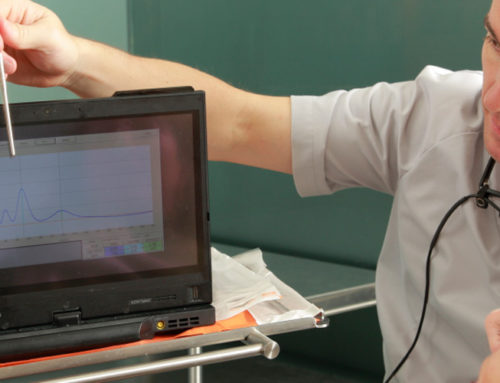A new “breath test” has been pioneered to specifically combat halitosis and bad breath, halfway between medicine and psychology.
One of the greatest difficulties in successfully treating halitosis or bad breath is that its origin has multiple causes and falls under several medical specialties.
One of the greatest difficulties in successfully treating halitosis or bad breath is that its origin has multiple causes and falls under several medical specialties. In spite of its complexity, the scientific establishment of the most frequent causes of halitosis, the appearance of modern diagnostic devices and the development of highly effective medical therapies allow us nowadays to diagnose and treat almost all cases.
“It is important to know the latest results derived from the investigation of a condition that most people still believe has its origin in the stomach or is due to poor oral hygiene. These are false beliefs about halitosis,” explains Dr. Jonas Nunes, a renowned expert in the fight against halitosis, who has run the Breath Institute since 2007.
“It’s true that the phenomena associated with the existence of halitosis can occur in different parts of the body: the mouth, nose, throat, lungs, stomach, intestine, liver, kidneys, etc. For this reason,” – he continues – “we cannot limit ourselves to a single specialty of medicine. Instead, we must collaborate with different health professionals like specialists in stomatology, otorhinolaryngology, gastroenterology, internal medicine, dentists, nephrology, clinical analytics, immune-allergology, as well as psychologists and nutritionists.”
How does the “breath test” work?
In the new breath test, halitosis is approached as a medical issue whose existence may be the manifestation of an underlying disease. In any case, it isn´t simply an aesthetic or cosmetic issue. According to the clinical approach of the Breath Institute, a patient with halitosis must follow three phases: diagnosis, treatment and control.
1st Phase: Diagnosis
Before beginning treatment, it is essential to obtain an etiological diagnosis. This is made in a single consultation, in which all the data of the patient – his or her current state of health and the medical history and background he or she has in relation to predisposing factors or triggers of halitosis – is collected. Next, other examinations are carried out, which include the computerized study of the breath (by means of gas chromatography), the study of saliva and the function of the salivary glands; also microbiological and enzymatic tests from bacterial plaque samples.
2nd Phase: Therapy/Treatment
“There is no single treatment to combat halitosis,” argues Dr. Nunes. “The only suitable treatment will be the one that takes into account the origin of the problem.”
Almost 83% of cases are solved with medication for topical or systemic use, which acts mainly in the interior of the oral cavity (antimicrobial and salivary stimulants, for example), in the respiratory system (such as topical corticosteroids) and in the digestive tract (drugs with action on gastroesophageal reflux, etc.). The remaining cases (17%) may include the elimination of infectious foci (case of dental curettage), surgeries (such as removal of tonsil crypts using CO2 laser), psychological therapy (cognitive psychotherapy in cases of halitophobia, for example), among others.
In the vast majority of cases, an improvement is observed three or four days after starting treatment.
3rd Phase: Control
The control phase begins once the halitosis remission is achieved. It normally includes one or two check-ups, “necessary,” says Dr. Nunes, “for the patient’s instruction in preventive measures and the realization of eventual procedures that ensure the maintenance of the results obtained.” Dr. Nunes goes on: “The improvement of the breath is evident by the attitude that the patients show in the check-ups, especially in the level of self-esteem. “However, it should be noted that, of the total number of successfully treated patients, 7% continue to behave three months later as if they were still suffering from halitosis. Defensive behaviors, such as hiding the mouth with the hand or regularly chewing gum often persist in these patients. However, after six months and after some Support sessions in which, with their collaboration, we confirm the absence of bad breath, the percentage is significantly reduced “, argues Dr. Nunes.
One of the most outstanding achievements of this multidisciplinary collaboration has been the application of the HCP Arthyaga® protocol, implemented by the Breath Institute itself. It has obtained international recognition for having achieved a global success rate of 97% in halitosis treatments (the highest success rate at present).
A consultation that takes emotions into account
In this new type of medical consultation, emotions often occupy a more prominent place than biology because it is demonstrated that halitosis can damage the self-esteem and self-confidence of the sufferer. It can also be a trigger for continued anxiety and stress. “The awareness of having bad breath” – explains Dr. Nunes – “triggers psychological consequences, with visible manifestations in behavior: gestures such as covering the mouth when speaking, maintaining a greater interpersonal distance or avoiding social relationships. Some of these can become serious “.
The simple act of smelling carries with it a huge emotional charge that can elicit approval or rejection, and even stimulate memory. According to Dr. Jonas Nunes, “smell has been considered not only the most emotional sense organ but also the most complex, due to the multiple emotional responses that odors produce in human beings.” The perception of an unpleasant breath generates the immediate increase of negative emotions, such as irritability, discomfort, nervousness and agitation. Some of the recent findings have clearly shown that the cerebral amygdala (limbic system) is stimulated by the perception of an odor, and that olfactory stimuli (positive or negative) influence emotions related to memory, language, spatial recognition and temperament.
Inevitably, in the social context, smells, emotions and body image interact dynamically and uninterruptedly. Dr. Nunes concludes: “And we all know that halitosis is an issue that determines social relations.”
Fortunately, it now has a solution.





